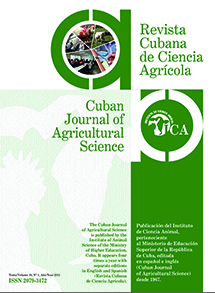Inoculation of substrate with lactic acid bacteria for the development of Moringa oleifera Lam plantlets
Contenido principal del artículo
Resumen
The objective of this study was to evaluate the inoculation of substrate with lactic acid bacteria in the development of Moringa oleifera Lam plantlets. For the production of lactic acid bacteria (LAB) three treatments with ferments of ripe tropical fruits were established: Musa spp. (banana LABB), Cucurbita pepo L. (pumpkin LABP) and Carica papaya L. (papaya LABP) and a control treatment. The application of these treatments was carried out in three moments of the Moringa oleifera development: to the sowing, with the first true leaves and ten days after this stage. The obtained results showed emergence percentages of 67, 61 and 61 % vs 34 % for LABP, LABP, LABB vs control, also at plant height (P < 0.001) and fresh weight (P < 0.001) and dry weight (P < 0.001).The higher values were obtained for the treatments with ALBP with respect to the control.
However, the root length was higher in LABP and LABB with respect to the rest of treatments (P < 0.001). In the number of leaves, a positive effect was obtained initially, favoring the use of LAB with respect to the control (P < 0.001), with no statistical effect on insertion of the first branch (P > 0.05). It is concluded that the use of inoculum of lactic bacteria from the fermentation with pumpkin, banana and papaya resulted in an ecotechnology that promotes the emergence and development of Moringa oleifera plantlets.
Key words: forage, growth, nursery, LAB, trees
However, the root length was higher in LABP and LABB with respect to the rest of treatments (P < 0.001). In the number of leaves, a positive effect was obtained initially, favoring the use of LAB with respect to the control (P < 0.001), with no statistical effect on insertion of the first branch (P > 0.05). It is concluded that the use of inoculum of lactic bacteria from the fermentation with pumpkin, banana and papaya resulted in an ecotechnology that promotes the emergence and development of Moringa oleifera plantlets.
Key words: forage, growth, nursery, LAB, trees
Detalles del artículo
Cómo citar
Anguiano Soto, J. M., Anguiano Cárdenas, J., & Palma García, J. M. (2017). Inoculation of substrate with lactic acid bacteria for the development of Moringa oleifera Lam plantlets. Cuban Journal of Agricultural Science, 51(2). Recuperado a partir de https://cjascience.com/index.php/CJAS/article/view/733
Sección
Ciencia de los pastos y otros cultivos
Aquellos autores/as que tengan publicaciones con esta revista, aceptan los términos siguientes:
- Los autores/as conservarán sus derechos de autor y garantizarán a la revista el derecho de primera publicación de su obra, el cuál estará simultáneamente sujeto a la Licencia Creative Commons Attribution-NonCommercial 4.0 International (CC BY-NC 4.0) que permite a terceros compartir la obra siempre que se indique su autor y su primera publicación esta revista. Bajo esta licencia el autor será libre de:
- Compartir — copiar y redistribuir el material en cualquier medio o formato
- Adaptar — remezclar, transformar y crear a partir del material
- El licenciador no puede revocar estas libertades mientras cumpla con los términos de la licencia
Bajo las siguientes condiciones:
- Reconocimiento — Debe reconocer adecuadamente la autoría, proporcionar un enlace a la licencia e indicar si se han realizado cambios. Puede hacerlo de cualquier manera razonable, pero no de una manera que sugiera que tiene el apoyo del licenciador o lo recibe por el uso que hace.
- NoComercial — No puede utilizar el material para una finalidad comercial.
- No hay restricciones adicionales — No puede aplicar términos legales o medidas tecnológicas que legalmente restrinjan realizar aquello que la licencia permite.
- Los autores/as podrán adoptar otros acuerdos de licencia no exclusiva de distribución de la versión de la obra publicada (p. ej.: depositarla en un archivo telemático institucional o publicarla en un volumen monográfico) siempre que se indique la publicación inicial en esta revista.
- Se permite y recomienda a los autores/as difundir su obra a través de Internet (p. ej.: en archivos telemáticos institucionales o en su página web) antes y durante el proceso de envío, lo cual puede producir intercambios interesantes y aumentar las citas de la obra publicada. (Véase El efecto del acceso abierto).
